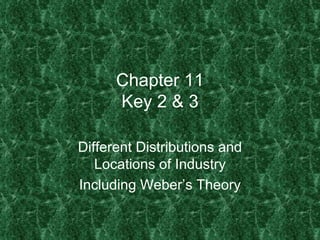
Chapter 11 key 2 & 3
- 1. Chapter 11 Key 2 & 3 Different Distributions and Locations of Industry Including Weber’s Theory
- 2. I Industrial Profits • Industries are in business to make money. In order to make money two important geographic factors must be considered – Situation factors involve transporting materials to and from a factory. A firm seeks a location that minimizes the cost of transporting inputs to the factory and finished goods to the consumer – Site Factors result from the unique characteristics of a location. Land, labor, and capital are the three traditional production factors that may vary among location.
- 3. II Situation Factors • Manufacturers buy materials, energy, machinery, and services know as inputs and sell finished products to consumers • Situation depends on the transportation costs associated with inputs and finished products. • If inputs cost more, factory will be located close to inputs, if finished product costs more, factory will be located near consumers
- 4. III Location Near Inputs • Inputs could be raw materials such as wood, minerals, or animals, or they could be parts or materials from other companies. If shipping these inputs is very expensive factories locate near inputs. • Often these are bulk-reducing industries where the input weighs more than the final product • Examples from the book to read and be familiar with – Copper Industry (page 381) – Steel Industry (page 381-382)
- 5. IV Location Near Markets • If products are more expensive to ship than inputs, manufacturers will locate closer to consumers. This type of situation is critical for three types of industries – Bulk-Gaining • Gains volume or weight during production. Examples include water and beer bottlers, fabricated products like TVs, refrigerators and cars – Single-Market • Companies that sell to one market in one location. Examples are textile components such as zippers, clasps, clips, and pins, as well as auto parts manufacturers. – Perishable • Mainly food products, but also include Newspapers
- 6. V Ship, Rail, Truck, Air • Costs are calculated to figure which type of transport is cheaper for inputs and products. • Regardless of mode of transportation, cost increase each time that an input or product switches modes. • Many companies locate at a Break-of-Bulk point, or where transfer among transportation modes is possible such as a seaports or airports • Currently situation in regards to markets and break-of –bulk points are more important than location near raw materials
- 7. VI Site Factors • The cost of conducting business also depends on three site production factors – Land – Labor – Capital
- 8. VII Land • Several factors are considered when it comes to selecting land to build a factory – Cost of land. Land usually is cheaper in suburban or rural areas – Available power sources. Every factory needs power, the cheaper the better – Other site influences such as climate, topography, recreation, cost of living and cultural facilities. Even major sports are sometimes considered
- 9. VIII Labor • Labor costs vary between countries as well as within regions of a country. • Some industries are labor-intensive industries where labor costs are a high percentage of a companies expenses. • Some labor-intensive industries require less skilled and inexpensive labor such as textile and clothing (see pages 388-392) others require highly skilled workers such as high tech industries. (see page 392)
- 10. IX Capital • Behold the power of MONEY • Companies need money to make products to sell. Companies will locate where there are people willing to invest in a product. • The San Francisco Bay area (Silicon Valley) was more dependant on people willing to risk money on high tech computer companies than the skilled labor force in the area. • Money is the main factor in the distribution of industry in LDCs. Governments try to show stability to attract MDC money for industry.
- 11. X Obstacles to optimum Location • Site and Situation can not always explain the location of a company • Some are said to be “Footloose” meaning that they can locate in a variety of places and be successful. • The knowledge of executives can make a difference • Personal preferences of executives can be a determining factor • Sometimes location is determined by history, mergers, cost of relocating, or other external factors
- 12. XI Weber’s Location Model or Least-Cost Theory • Alfred Weber developed a model for secondary industry much as Von Thunen developed a model for agriculture based on Site and Situation. His model to determine the comparative advantage (the advantage of one location over another) of locations took three factors into account – Transportation – Labor – Agglomeration • This is when a large number of businesses cluster in the same area to assist and supply each other. Over agglomeration can lead to high rent, high wages, and transport costs and result in deglomeration where industries move from crowded urban areas
